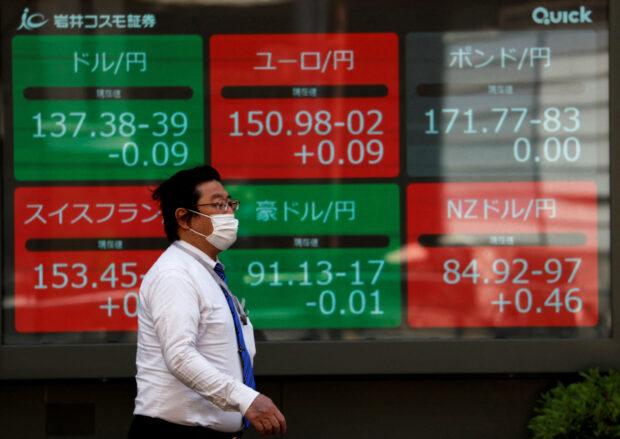
A man walks past an electric monitor displaying the Japanese yen exchange rate against the U.S. dollar, Euro and other foreign currencies outside a brokerage in Tokyo, Japan May 2, 2023. REUTERS/Issei Kato/file photo
SINGAPORE – Asian stocks rose, the dollar eased and gold hovered near record highs on Friday, as investors worried that a rout in shares of U.S. regional lenders earlier this week could herald more trouble for the banking sector.
MSCI’s broadest index of Asia-Pacific shares outside Japan was 0.44 percent higher and was on course to snap its two-week losing streak as investors bet that the Federal Reserve may soon have to cut interest rates.
As investors flocked to safe haven assets, spot gold moved closer to its record high and the yen appeared set for its first weekly gain in nearly a month.
Shares of U.S. regional banks sank this week after the collapse of First Republic Bank, bringing back worries of a widening banking sector crisis that began with the collapse of Silicon Valley Bank in March.
“There is increasing nervousness about the banking problems in the U.S. and I fear that the central banks are going too far,” said Shane Oliver, chief economist at AMP Capital in Sydney.
“There seems to be a view among central banks that they’ve got it under control, whereas the means that they’ve used to try and control it, are actually creating more problems.”
Wall Street ended lower on Thursday after Los Angeles-based PacWest Bancorp’s move to explore strategic options deepened fears about the health of U.S. lenders as pressure grows on regulators to take more steps to shore up the country’s banking sector.
https://business.inquirer.net/399394/wall-street-ends-down-as-pacwest-fuels-fears-of-deeper-bank-crisis
Shares of another regional lender Western Alliance pared losses after plummeting by nearly 60 percent on a Financial Times report that it was exploring strategic options. Western Alliance denied the report.
“There is a risk that we enter a self-fulfilling cycle of negative sentiment leading to lower stock prices, higher funding costs and deposit flight,” said James Rutherford, head of European equities at Federated Hermes.
The turmoil in the banking sector comes as the Federal Reserve raised interest rates by 25 basis points on Wednesday but hinted that its marathon hiking cycle may be ending.
Markets are pricing for the Fed to stand pat at its next meeting in June before embarking on rate cuts from July, according to CME FedWatch tool.
“There is plenty of data between now and the June 14 Fed meeting, with what happens in the banking sector being more key at the moment,” Saxo Markets strategists said.
U.S. nonfarm payroll data for April will be released later in the global day.
European stock markets looked set for a higher open, with Eurostoxx 50 futures up 0.42 percent, German DAX futures up 0.39 percent and FTSE futures up 0.33 percent.
On Thursday, the European Central Bank raised interest rates by 25 basis points to 3.25 percent and signaled that more tightening would be needed to tame inflation. Markets though pared back their expectations on how much further rates would rise.
https://business.inquirer.net/399355/ecb-raises-rates-by-25-bps-in-inflation-fight
Nick Rees, FX market analyst at Monex Europe, said it was clear that the ECB is now in the home stretch when it comes to monetary tightening, despite ECB President Christine Lagarde’s attempt to steer markets away from this narrative.
China shares fell 0.71 percent, while Hong Kong’s Hang Seng index was up 0.6 percent.
China’s service activity grew for a fourth straight month in April, a private-sector survey showed on Friday, as businesses continued to benefit from the country’s reopening, although expansion slowed slightly.
E-mini futures for the S&P 500 rose 0.35 percent after Apple Inc’s results beat expectations, helped by better-than-expected iPhone sales and notable inroads in India and other newer markets.
In the currency market, the Japanese yen strengthened 0.20 percent to 134.04 per dollar, on course for its first weekly gain in nearly a month.
Sterling was last trading at $1.26095, up 0.27 percent on the day, having touched an 11-month high of $1.26150. The euro firmed 0.27 percent to $1.10435.
Against a basket of currencies, the dollar eased 0.17 percent to 101.17.
Meanwhile, spot gold eased 0.1 percent to $2,049.68 an ounce, hovering close to its all-time high of $2,072.49.
U.S. crude rose 0.77 percent to $69.09 per barrel and Brent was at $73.07, up 0.79 percent on the day. Still, oil prices were set for a third straight week of losses after markets witnessed dramatic drops on fears of a weakening U.S. economy and slowing Chinese demand.